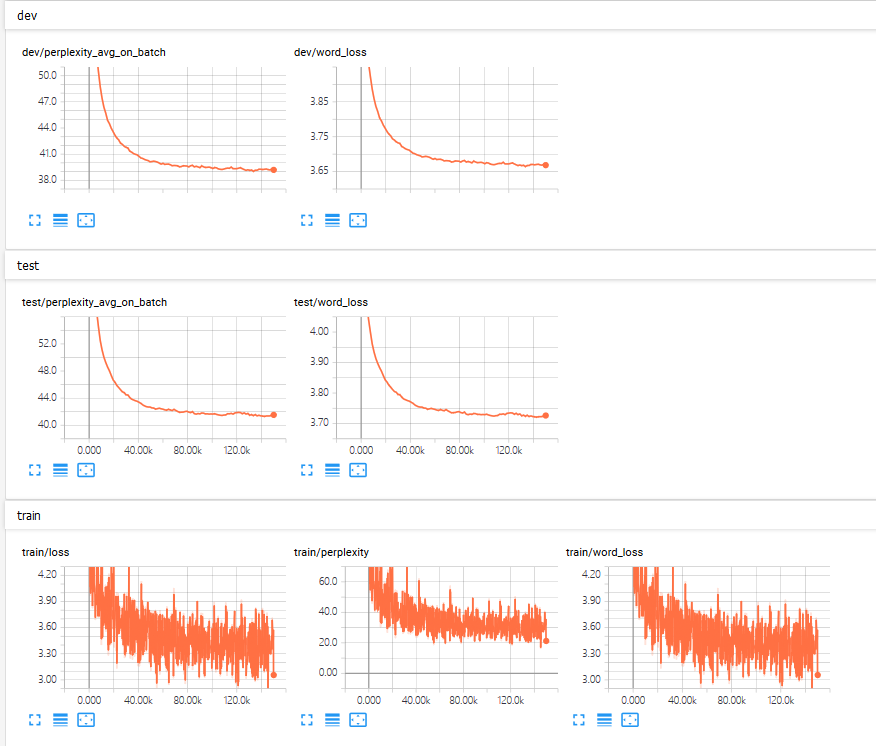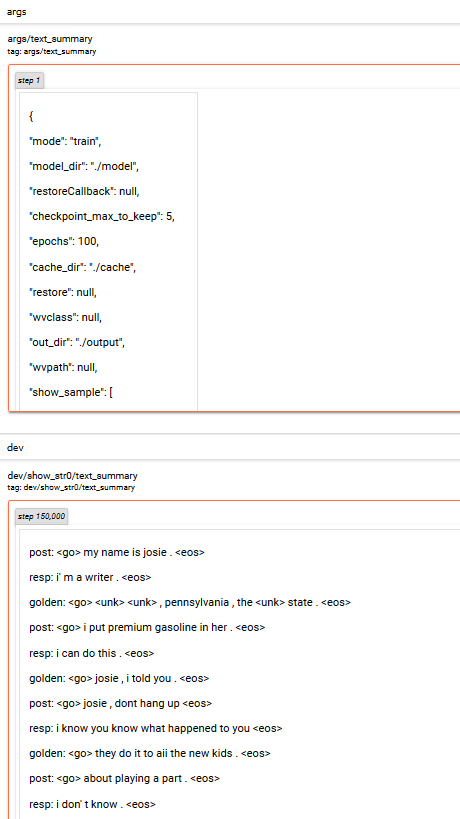

Seq2Seq (PyTorch)¶
Seq2seq with attention mechanism is a basic model for single turn dialog. In addition, batch normalization and dropout has been applied. You can also choose beamsearch, greedy, random sample, random sample from top-k when decoding.
You can refer to the following paper for details:
Sutskever, I., Vinyals, O., & Le, Q. V. (2014). Sequence to sequence learning with neural networks. In Advances in neural information processing systems (pp. 3104-3112).
Bahdanau, D., Cho, K., & Bengio, Y. (2015). Neural machine translation by jointly learning to align and translate. In International Conference on Learning Representation.
Require Packages¶
python3
cotk
pytorch == 1.0.0
tensorboardX >= 1.4
Quick Start¶
Using
cotk download thu-coai/seq2seq-pytorch/masterto download codes.Execute
python run.pyto train the model.The default dataset is
OpenSubtitles. You can use--datasetto specify otherdataloaderclass and--dataidto specify other data path (can be a local path, a url or a resources id). For example:--dataset OpenSubtitles --dataid resources://OpenSubtitlesIt doesn’t use pretrained word vector by default setting. You can use
--wvclassto specifywordvectorclass and--wvpathto specify pretrained word embeddings. For example:--wvclass gloves. For example:--dataset Glove --dataid resources://Glove300If you don’t have GPUs, you can add
--cpufor switching to CPU, but it may cost very long time for either training or test.
You can view training process by tensorboard, the log is at
./tensorboard.For example,
tensorboard --logdir=./tensorboard. (You have to install tensorboard first.)
After training, execute
python run.py --mode test --restore bestfor test.You can use
--restore filenameto specify checkpoints files, which are in./model. For example:--restore pretrained-opensubtitlesfor loading./model/pretrained-opensubtitles.model--restore lastmeans last checkpoint,--restore bestmeans best checkpoints on dev.--restore NAME_lastmeans last checkpoint with model named NAME. The same as--restore NAME_best.
Find results at
./output.
Arguments¶
usage: run.py [-h] [--name NAME] [--restore RESTORE] [--mode MODE] [--lr LR]
[--eh_size EH_SIZE] [--dh_size DH_SIZE] [--droprate DROPRATE]
[--batchnorm] [--decode_mode {max,sample,gumbel,samplek,beam}]
[--top_k TOP_K] [--length_penalty LENGTH_PENALTY]
[--dataset DATASET] [--dataid DATAID] [--epoch EPOCH]
[--batch_per_epoch BATCH_PER_EPOCH] [--wvclass WVCLASS]
[--wvid WVID] [--out_dir OUT_DIR] [--log_dir LOG_DIR]
[--model_dir MODEL_DIR] [--cache_dir CACHE_DIR] [--cpu]
[--debug] [--cache] [--seed SEED]
A seq2seq model with GRU encoder and decoder. Attention, beamsearch, dropout
and batchnorm is supported.
optional arguments:
-h, --help show this help message and exit
--name NAME The name of your model, used for tensorboard, etc.
Default: runXXXXXX_XXXXXX (initialized by current
time)
--restore RESTORE Checkpoints name to load. "NAME_last" for the last
checkpoint of model named NAME. "NAME_best" means the
best checkpoint. You can also use "last" and "best",
by default use last model you run. Attention:
"NAME_last" and "NAME_best" are not guaranteed to work
when 2 models with same name run in the same time.
"last" and "best" are not guaranteed to work when 2
models run in the same time. Default: None (don't load
anything)
--mode MODE "train" or "test". Default: train
--lr LR Learning rate. Default: 0.001
--eh_size EH_SIZE Size of encoder GRU
--dh_size DH_SIZE Size of decoder GRU
--droprate DROPRATE The probability to be zerod in dropout. 0 indicates
for don't use dropout
--batchnorm Use bathnorm
--decode_mode {max,sample,gumbel,samplek,beam}
The decode strategy when freerun. Choices: max,
sample, gumbel(=sample), samplek(sample from topk),
beam(beamsearch). Default: beam
--top_k TOP_K The top_k when decode_mode == "beam" or "samplek"
--length_penalty LENGTH_PENALTY
The beamsearch penalty for short sentences. The
penalty will get larger when this becomes smaller.
--dataset DATASET Dataloader class. Default: OpenSubtitles
--dataid DATAID Resource id for data set. It can be a resource name or
a local path. Default: resources://OpenSubtitles
--epoch EPOCH Epoch for training. Default: 100
--batch_per_epoch BATCH_PER_EPOCH
Batches per epoch. Default: 1500
--wvclass WVCLASS Wordvector class, none for not using pretrained
wordvec. Default: Glove
--wvid WVID Resource id for pretrained wordvector. Default:
resources://Glove300d
--out_dir OUT_DIR Output directory for test output. Default: ./output
--log_dir LOG_DIR Log directory for tensorboard. Default: ./tensorboard
--model_dir MODEL_DIR
Checkpoints directory for model. Default: ./model
--cache_dir CACHE_DIR
Checkpoints directory for cache. Default: ./cache
--cpu Use cpu.
--debug Enter debug mode (using ptvsd).
--cache Use cache for speeding up load data and wordvec. (It
may cause problems when you switch dataset.)
--seed SEED Specify random seed. Default: 0
TensorBoard Example¶
Execute tensorboard --logdir=./tensorboard, you will see the plot in tensorboard pages:

Following plot are shown in this model:
gen/loss (
genmeans training process)gen/perplexity (
=exp(gen/word_loss))gen/word_loss (
=gen/lossin this model)dev/loss
dev/perplexity_avg_on_batch
test/loss
test/perplexity_avg_on_batch
And text output:

Following text are shown in this model:
args
dev/show_str%d (
%dis according toargs.show_sampleinrun.py)
Case Study of Model Results¶
Execute python run.py --mode test --restore best
The following output will be in ./output/[name]_[dev|test].txt:
perplexity: 48.194050
bleu: 0.320098
post: my name is josie .
resp: <unk> <unk> , pennsylvania , the <unk> state .
gen: i' m a teacher .
post: i put premium gasoline in her .
resp: josie , i told you .
gen: i don' t know .
post: josie , dont hang up
resp: they do it to aii the new kids .
gen: aii right , you guys , you know what ?
post: about playing a part .
resp: and thats the theme of as you like it .
gen: i don' t know .
......
Experiment¶
Subset Experiment¶
Based on OpenSubtitles_small (a smaller version of OpenSubtitles), we did the following experiments.
encoder |
decoder |
batchnorm |
learning rate |
droprate |
dev perplexity |
test perplexity |
|---|---|---|---|---|---|---|
175 |
175 |
no |
0.0001 |
0.2 |
88.971 |
94.698 |
128 |
128 |
no |
0.0001 |
0 |
95.207 |
100.676 |
128 |
128 |
no |
0.0001 |
0.2 |
93.559 |
99.287 |
128 |
128 |
yes |
0.0001 |
0 |
105.649 |
112.818 |
128 |
128 |
yes |
0.0001 |
0.2 |
95.894 |
102.243 |
150 |
150 |
no |
0.0001 |
0.2 |
90.153 |
95.072 |
256 |
256 |
no |
0.0001 |
0.2 |
89.374 |
94.272 |
175 |
175 |
yes |
0.0001 |
0.2 |
97.704 |
102.851 |
175 |
175 |
no |
0.0001 |
0.1 |
90.149 |
95.310 |
175 |
175 |
no |
0.0001 |
0.3 |
89.750 |
95.042 |
175 |
175 |
no |
0.0005 |
0.2 |
88.688 |
93.421 |
The following experiments are based on the parameters of the first experiment.
To reproduce the experiment, run the following command to train the model:
python run.py --dataset=OpenSubtitles --dataid resources://OpenSubtitles_small --eh_size 175 --dh_size 175 --droprate 0.2 --epoch 35 --lr 0.0001
Based on the best parameters, we did another five experiments in order to analyze the model’s performance totally.
seed |
dev perplexity |
test perplexity |
dev bleu(x1e-3) |
test bleu(x1e-3) |
|---|---|---|---|---|
7913 |
89.123 |
93.898 |
3.24 |
2.82 |
1640 |
88.224 |
94.019 |
4.51 |
4.13 |
3739 |
87.969 |
92.730 |
2.37 |
2.15 |
972 |
88.083 |
93.515 |
2.99 |
2.34 |
3594 |
87.933 |
94.258 |
4.22 |
3.44 |
Average |
88.266 ± 0.440 |
93.684 ± 0.534 |
3.47 ± 7.92 |
2.98 ± 7.29 |
Run the following command to test the trained model:
python run.py --dataset=OpenSubtitles --dataid resources://OpenSubtitles_small --eh_size 175 --dh_size 175 --decode_mode samplek --droprate 0.2 --epoch 35 --mode test --restore [model name] --seed [seed value]
Fullset experiment¶
Based on the result of subset experiment, we did the following experiment on OpenSubtitles.
Parameters |
Value |
|---|---|
encoder |
256 |
decoder |
256 |
batchnorm |
no |
learning rate |
0.0003 |
droprate |
0.2 |
epoch |
200 |
seed |
0 |
decode mode |
dev perplexity |
test perplexity |
dev bleu(x1e-3) |
test bleu(x1e-3) |
|---|---|---|---|---|
samplek |
41.457 |
43.868 |
3.24 |
2.82 |
beam |
41.457 |
43.868 |
11.5 |
10.4 |
To reproduce the experiment, run the following command to train the model:
python run.py --dataset=OpenSubtitles --dataid resources://OpenSubtitles --eh_size 256 --dh_size 256 --droprate 0.2 --lr 0.0003 --epoch 200
Run the following command to test the trained model:
python run.py --dataset=OpenSubtitles --dataid resources://OpenSubtitles --eh_size 256 --dh_size 256 --decode_mode [decode mode] --droprate 0.2 --lr 0.0003 --epoch 200 --mode test --restore best
Performance¶
Perplexity |
BLEU |
|
|---|---|---|
OpenSubtitles |
43.868 |
0.0115 |